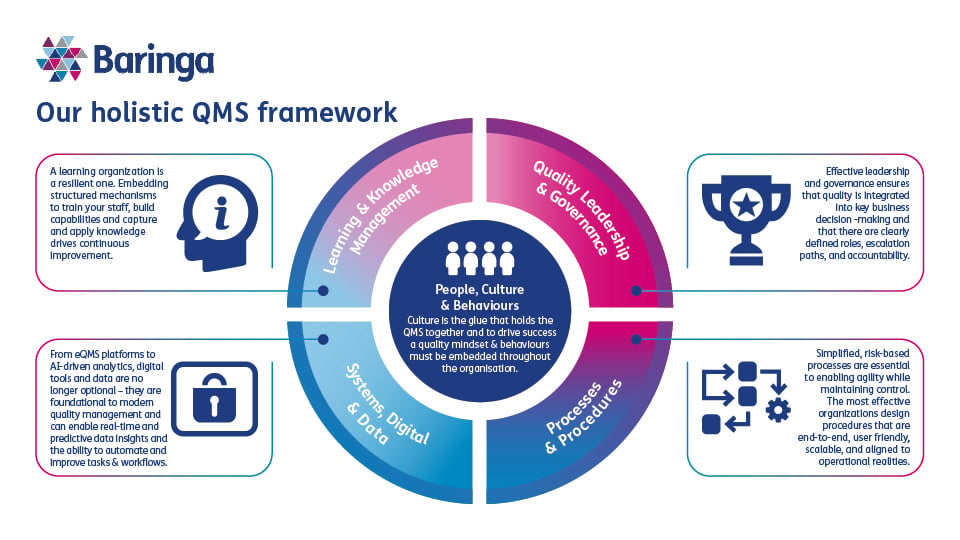
Redefining quality in Pharma and Life Sciences: A strategic imperative
7 min read 23 July 2025
As regulations, technology and patient expectations continue to place increasing expectations on pharma and life sciences organisations; quality efforts must go beyond traditional compliance. For these organisations, a bold approach to quality is not just a necessity - it’s a strategic advantage.
By anchoring quality to a clear vision and a holistic quality strategy, pharma and life science organisations can ensure that quality is not just a regulatory requirement but a strategic priority - supporting innovation, accelerating time to market, and building trust with regulators, partners, and patients.
In this article we explore how organisations can approach redefining quality and unlocking the anticipated benefits, drawing up on Baringa’s experience supporting organisations across these core steps:
- Create a quality vision that inspires your people
- Align leadership on the strategic and operational principles that will support defining and implementing a quality strategy
- Define a holistic quality strategy that translates the quality vision into a tangible action plan
- Design and implement a fit-for-purpose Quality Management System (QMS) to execute your strategy
- Consider key ‘get-rights’ for your quality transformation
1. Create an inspiring quality vision
A quality vision is a shared ambition that articulates what an organisation aims to achieve through its quality efforts and calls the organisation to action. A clear statement outlining how quality enables and underpins all strategic and operational priorities, as well as committing all individuals to own quality sets the tone and shape of how leaders and teams communicate and act on quality across the organisation.
From our experience, here are three critical aspects of successfully defining and embedding a strong quality vision across biopharma organisations:
- The vision should directly align with the organisation’s broader purpose, values and culture, avoiding general statements that will challenge individuals to identify and resonate with the vision.
- We encourage organisations to be bold, and we actively challenge leaders to see quality as a key driver for strategic priorities, shifting the vision from centering on reactive compliance and moves it to proactive value creation.
- The success of a strong quality vision is heavily reliant on cross-functional leadership alignment and buy-in, and empowering leaders to role-model the vision, consistently communicate it and reinforce it with their teams.
When done well, the quality vision is what drives an organisation to embrace quality and transforms it into one that continuously exceeds expectations, delivers exceptional value and builds long standing trust and a positive reputation with stakeholders.
2. Align leadership on the strategic and operational principles that will support defining and implementing a quality strategy
Strategic and operational principles are a critical ‘golden thread’ in being able to realise the benefit from ‘redefining quality’. Not only do principles set the scope and direction of the quality strategy based on organisational strategies and vision, they also enable streamlined translation of the designed quality strategy into operational plans and operating models to implement.
Focussing on leadership alignment around these principles ensures that there is full understanding on the core components of the organisation, often overlooked in the haste to move from visioning to strategy.
Critical areas to align on principles are:
- The boundaries of the organisation’s desired QMS – decide whether your QMS will be enterprise wide, for example, or if there will be separate QMSs across R&D and supply chain, and how these will interact and connect.
- Be deliberate about capability ownership - deciding where to build internal expertise and where to partner with third parties.
- Determine and challenge the level of risk appetite and how that will filter down into the organisation, so that people can make risk-based decisions.
- Agree the level of control to enable agility, allowing teams to innovate and respond quickly to change without compromising standards.
- Define end-to-end accountability, driving quality ownership and outcomes across the value chain.
- Have a bold digital ambition – identify where technology and AI add the most impact so you can embed predictive analytics, automation and AI across the value chain to accelerate delivery and enable fast decision-making and issue resolution.
- Be clear on the expectations for patient-centricity and continuous improvement - reinforcing the idea that quality is not a checkpoint, but a mindset.
Our experience in successfully defining and agreeing clear principles emphasises the importance of leadership buy-in to ensure that the resultant quality strategy and operational plans gain commitment from across the organisation.
3. Define a holistic quality strategy that underpins organisational objectives and translates the quality vision into a tangible action plan
A clear quality strategy is the core component of delivering the strategic benefits of quality within pharma and life sciences organisations. Acting as the bridge between vision and execution, the strategy guides investment in technology, business operations and people, that enable consistent, scalable, and resilient quality outcomes.
Our experience in designing quality strategies is that you need to consider all aspects of business operations and strategic intent to maximise the full benefit of quality across the entire organisation. Our Baringa QMS framework (see below) provides a clear structure to ensure you consider all of the key aspects.
In addition, organisations must have an objective view of their current quality maturity and how far away they are from their defined quality strategy. Measuring where each function is today compared to the defined quality strategy is fundamental so that organisations can build a realistic roadmap of priorities to achieve their quality vision.
We have developed a quality maturity framework which we use with our clients to assess their quality maturity and identify what actions need to be taken move them along the maturity scale.
Once an organisations has its quality strategy in place, it’s imperative that they regularly monitor and review progress against it, so that they can pinpoint problems, adapt approaches and highlight successes to drive momentum.
4. Design and implement a fit-for-purpose QMS
Although a QMS is typically defined as a set of structured processes, systems and responsibilities for executing your quality strategy – we see it as more than this. In addition to the aforementioned, a well-designed and effective QMS takes into consideration governance; learning and knowledge management; people, culture and behaviours, and digital and data.
Having an effective, fit-for-purpose QMS brings with it significant benefits, not limited to:
- Improved operational consistency
- Increased efficiency and productivity
- Ongoing commitment to continuous improvement
- Enhanced stakeholder satisfaction
- Informed, data-driven decision-making
- Greater employee engagement and motivation
- Increased business profitability
We have used our expertise to guide many pharma and life sciences companies in assessing, developing, and implementing tailored QMS that achieve successful business outcomes.
Our Baringa QMS framework outlines the core components to be considered when designing a QMS:
Read more about our QMS framework
Across our experience of supporting organisations on their quality journey, the companies that are most successful are the ones that apply equal importance to all aspects of the QMS framework.
However, organisations must be realistic about the time, cost and effort to reach the desired state for their QMS. It doesn’t all have to happen at once – organisations can take an incremental approach, focus on first implementing the elements of the QMS that will drive the most value across the organisation. Building over time also allows you to take a more considered and diligent approach to change management and demonstrate benefits that can ultimately help you achieve a sustainable QMS.
5. Consider key ‘get-rights’ for your quality transformation
Despite the best intentions, many companies struggle to realise the benefits of a well-designed quality strategy or tailored QMS. Based on our extensive quality experience, we have a number of key ‘get-rights’ for organisations to achieve a successful and sustainable quality transformation:
- Take a holistic approach: there’s more to quality than just processes and audits – ensure you define a quality vision so that quality is seen a strategic enabler rather than a tick-box compliance exercise.
- Align leaders: involve key functions and leaders from across the business right from the start so that there is cross-functional alignment on the vision and strategy, and hold them to account for delivery of the QMS.
- Be people-led: Design your quality strategy with people at the heart, embed the user-experience and ensure engaging change management to drive the right quality behaviours.
- Keep it simple: When designing your QMS, apply lean principles and design with end users in mind – make quality easy for everyone and reduce unnecessary complexity.
- Be tech-enabled : Data, digital, and AI solutions should be integrated into all areas of your QMS, focus on solutions that will bring the most value to accelerate at scale and drive user adoption.
- Measure impact: Define KPIs and success measures so you can effectively assess the effectiveness of change and demonstrate return on investment.
How Baringa can support in making quality a strategic differentiator
Achieving a clear quality vision, robust quality strategy, and a fit-for-purpose QMS, unlocks the ability for organisations to innovate, accelerate time to market and build trust with regulators, patients and partners.
At Baringa, we use our broad experience of the life sciences sector and quality expertise to support pharmaceutical and life sciences companies in making quality a strategic differentiator. We can work hand-in-hand with you to:
- Create a quality vision that supports strategic goals and inspires your people, ensuring alignment across senior leaders
- Help define the strategic and operational principles that will guide the quality strategy and support successful implementation
- Develop a quality strategy that guides the organisation as it builds the capabilities needed to achieve its quality vision, understanding areas of maturity and key growth opportunities
- Design and implement a tailored Quality Management System, that provides a flexible framework to drive innovation, improve decision-making, and accelerate time to market
- Craft a tailored transformation approach that translates the Quality strategy into reality, with bespoke change and engagement methodologies that enable buy in and commitment across the organisation
Get in touch with our Pharmaceutical and Life Sciences experts Chris Maxted, Amy Salmon, or Demi Dabor-Alloh to find out more about how we can help make quality a strategic differentiator for your organisation.
Our Experts




Related Insights

Enabling commercial agility in medical device manufacturing
A global medical device company was operating with limited visibility across its commercial and operational functions.
Read more
A focused integrated evidence planning approach that identified over >£10m of savings in one year
Our client was a leading global pharmaceutical company with an ambitious 5-year pipeline of launches that required a cross-functional step-change in how they approached evidence generation.
Read more
Unlocking the power of patient insight to revolutionise clinical trial design
When we talk about clinical trials, discussions often centre on regulatory demands, data integrity, endpoints, and scientific outcomes. While these are undeniably critical, what frequently gets overlooked is the perspective that matters most - the patients.
Read more
Preparing a global biotech company for inspection readiness
Always being inspection ready is integral to maintaining an effective Quality Management System (QMS), ensuring regulatory compliance, safeguarding the quality and safety of pharmaceutical products, and reducing risks and issues.
Read moreIs digital and AI delivering what your business needs?
Digital and AI can solve your toughest challenges and elevate your business performance. But success isn’t always straightforward. Where can you unlock opportunity? And what does it take to set the foundation for lasting success?
